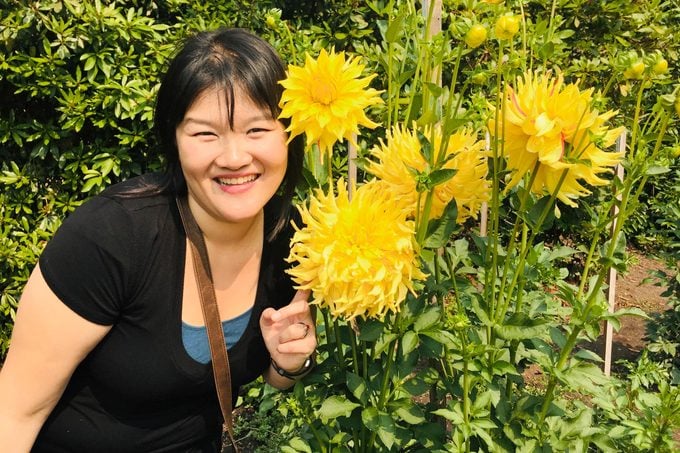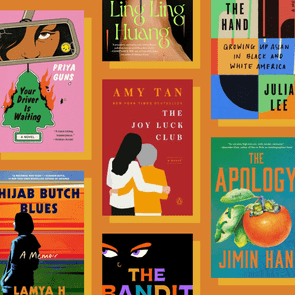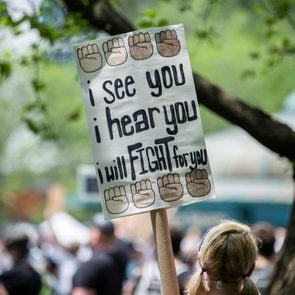What Does AANHPI Mean? A Proud Asian American Explains
Updated: May 16, 2023

I love my uniquely Chinese Korean American cultural identity, but I'm also happy to embrace being an AANHPI. Here's why.
Even for a proud Asian American like me, the evolution of the latest Asian identity acronyms can be a bit complicated. But the evolving name adds significance to May’s Asian American, Native Hawaiian and Pacific Islander (AANHPI) Heritage Month, which is a hard-fought-for commemorative period. Formerly known as Asian American and Pacific Islander Heritage Month, or AAPI Month, this month honors the rich and diverse cultures, traditions and contributions of AANHPIs to the United States. The AANHPI meaning, as you may have guessed, is far from monolithic. Each culture encompassed represents a vibrant group of people, with unique backgrounds, experiences and stories.
While we can celebrate AANHPI Heritage Month in the month of May by reading Asian American books, supporting Asian-owned companies and honoring the achievements of AANHPI individuals who have contributed to American society in countless ways, all this can and should be done year-round as well. Collectively reflecting on the challenges that AANHPI communities have faced and continue to face, such as discrimination and marginalization, as members of the BIPOC community is also a worthy and meaningful way to observe the month. Ahead, I’ll dive into the AANHPI meaning, its history and what it means to identify as an AANHPI.
Get Reader’s Digest’s Read Up newsletter for more knowledge, humor, cleaning, travel, tech and fun facts all week long.
What does AANHPI mean?
AANHPI stands for Asian American Native Hawaiian Pacific Islander, which is an umbrella term for people with these backgrounds who are living in the United States and its territories. The Biden-Harris administration first added “Native Hawaiian” to what was previously known as AAPI in its AANHPI Heritage Month proclamation in 2021.
And the month of May is loaded with symbolism. The first Japanese immigrant arrived on U.S. soil on May 7, 1843, and the Transcontinental Railroad, largely built by Chinese immigrant laborers, was completed on May 10, 1869.
Who first developed the term AANHPI?
Congressional staffer Jeanie Jew, a fourth-generation Chinese American descendant of a Transcontinental Railroad worker, was the first to propose the idea of an Asian Pacific American heritage month in the mid-1970s. Representatives Frank Horton and Norman Mineta, along with senators Daniel Inouye and Spark Matsunaga, first formally introduced respective proposals in the House and Senate in 1977, but both resolutions failed. The next year, a joint resolution was eventually passed and signed by President Jimmy Carter, declaring Asian Pacific American Heritage Week as the first 10 days of May in 1979.
Believe it or not, the commemorative period wasn’t extended into a full month until 1990, by President George H.W. Bush. In 2009, President Barack Obama updated the name to Asian American Pacific Islander (AAPI) Heritage Month to better represent those native to the Hawaiian Islands and the U.S. Pacific Island territories. And finally, as mentioned earlier, President Joe Biden took additional steps to distinguish Native Hawaiians in 2021, declaring May as Asian American Native Hawaiian Pacific Islander Heritage Month.
Who identifies as AANHPI?
For a variety of reasons, how an individual identifies can be deeply personal, especially if someone is mixed race, adopted or multicultural. This makes guessing or assuming a person’s identity ill-advised.
But if you’re wondering who might, generally speaking, identify as Asian American, those from the Asian diaspora, or Asians whose families originate from an Asian country—such as China, India, Vietnam and Kazakhstan—might identify as Asian American. Native Hawaiian are ethnic, indigenous Hawaiians, while other Pacific Islanders in this context refers to those of Polynesian, Micronesian and Melanesian heritage, including those whose families originate from Guam, Samoa, Fiji and more. Some of the best Asian American podcasts delve into the uniqueness of these individual communities, as well as what it means to be considered AANHPI.
Who is in the AANHPI community?
The U.S. Census Bureau published data in 2020 for 21 different detailed groups making up the more than 20 million Asian-identifying people in the country, including Chinese, Indian, Filipino, Vietnamese, Korean, Japanese, Pakistani, Hmong, Cambodian, Thai, Taiwanese, Laotian, Bangladeshi, Burmese, Nepalese, Indonesian, Sri Lankan, Bhutanese, Mongolian, Okinawan and more.
The Native Hawaiian and other Pacific Islander communities number more than 1.5 million and include Samoans, Tongan, Chamorro, Marshallese, Fijian and other Polynesian, Micronesian, Melanesian and other Pacific Islanders.
Anyone of mixed-race AANHPI heritage, and who identifies as such, is also included in the community.
What AANHPI means to me

I’m ethnic Chinese, born in South Korea. My family immigrated to the United States when I was a child. As proud as I am of my specific Chinese Korean American cultural identity, I am also happy to embrace being AANHPI. What being AANHPI means to me is to finally belong. For generations, my ancestors had been displaced, with citizenship in one country and residency in another, with laws and wars slicing borders and dividing our family. When we became naturalized, this cycle of displacement ended for the first time in a century.
My AANHPI identity also comes with national, governmental recognition as a member of a celebrated community, whose contributions and sacrifices are formally seen. Interning in Washington, D.C., at OCA-National, a AANHPI civil rights organization, solidified my social justice–minded identity. That summer in college more than 20 years ago, I worked alongside Asian Americans and Pacific Islanders from all over the country for a common goal. After growing up in Arizona, in cities where there weren’t as many Asians, coming together at our nation’s capital was incredibly empowering. As interns, we met with legislators like the late Rep. Norman Mineta, Rep. Mike Honda and many others who were instrumental in fighting for AANHPI rights over the years, and I became a part of that fight too.
We are stronger together
Though AANHPIs are the fastest-growing demographic, we currently make up less than 8% of the total U.S. population. We are still marginalized by being reduced to harmful stereotypes, suffering under the model minority myth and being used as a scapegoat for national issues. Since moving to the United States as a child, I’ve been called racial slurs, threatened, shoved and have had sexually charged racist comments shouted at me. Racism doesn’t distinguish one Asian ethnicity from another and seeks to hurt us all.
But by combining our voices and pooling our resources as allies within the diverse AANHPI communities, we can more effectively fight for inclusion, justice and do our best to end hate. Without a doubt, we are safer, stronger and more powerful when our communities band together. And that’s why I am someone culturally both Chinese and Korean American who also embraces the AANHPI identity.
Sources:
- U.S. Census Bureau: “20.6 Million People in the U.S. Identify as Asian, Native Hawaiian or Pacific Islander”
- U.S. Census Bureau: “Census 2000 Brief: The Native Hawaiian and Other Pacific Islander Population: 2000”
- UC Santa Barbara American Presidency Project: “Proclamation 8369—Asian American and Pacific Islander Heritage Month, 2009”
- The White House: “A Proclamation on Asian American and Native Hawaiian / Pacific Islander Heritage Month, 2021”
- Rowan University DEI Blog: “Asian Pacific American Heritage Month”





















